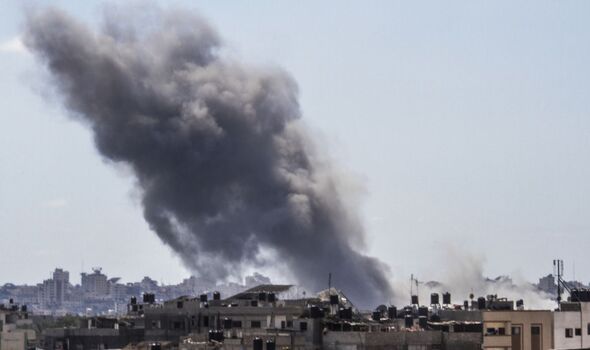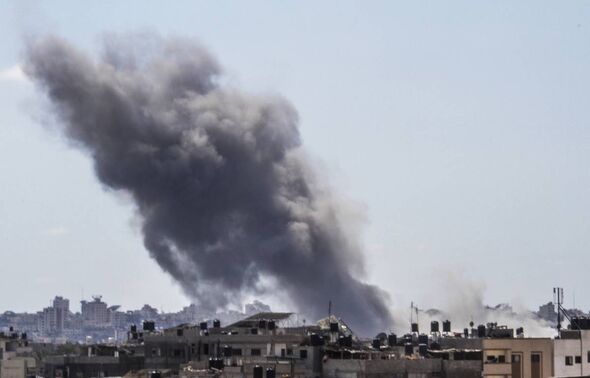
JABALIA, GAZA – APRIL 13: Smoke rises after Israeli attack on Jabalia Refugee Camp on April 13, 2024 in Jabalia, Gaza. (Photo by Mahmoud Issa/Anadolu via Getty Images) (Image: Anadolu via Getty Images)
The Middle East is teetering on the brink of full-scale war as Iran’s near-fatal 300-strong revenge barrage has escalated tensions with Israel.
As Israel strategises its next move against Tehran, western diplomats are frantically attempting to dissuade it from igniting an explosion of violence in the region.
The Israeli war cabinet is already under international scrutiny for the high number of Palestinian civilian casualties in the Gaza conflict with Hamas.
US President Joe Biden, supported by the UK, is at the forefront of condemning Iran’s strikes while simultaneously urging Israel not to impulsively escalate the conflict.
It seems almost inconceivable that Israel will not retaliate to the Tehran assault with a strike within Iran, propelling the region towards a terrifying spiral of conflict.
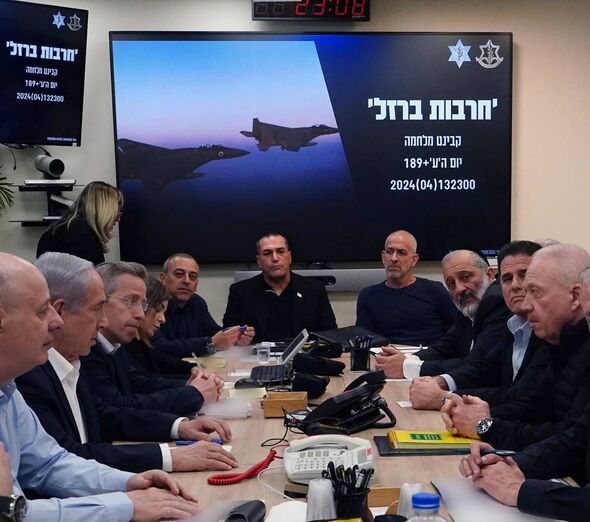
TEL AVIV, ISRAEL – APRIL 14: (—-EDITORIAL USE ONLY – MANDATORY CREDIT – ISRAELI MINISTRY OF DEFENSE – ARIEL HERMONI / HANDOUT’ – NO MARKETING NO ADVERTISING CAMPAIGNS – DISTRIBUTED AS A SERVICE TO CLIENTS—-) The Israel’s war cabinet, chaired by Prime Minister Benjamin Netanyahu (2nd L), meeting is held to discuss the drone attack launched by Iran in Tel Aviv, Israel on April 14, 2024. (Photo by Israeli Ministry of Defense / Handout/Anadolu via Getty Images) (Image: Anadolu via Getty Images)
The potential for a wider conflict, involving Tehran’s proxies in Lebanon, Syria, Iraq and Yemen, could lead towards a much larger war.
Iran’s loose alliances with Russia and China make it even more critical that Israel‘s next move does not provoke a violent response from Tehran, reports the Mirror.
This would inevitably involve American forces and possibly UK forces deployed to protect Israel, as they have already done in this first direct Iranian attack.
Chris Hughes, Defence Editor at The Mirror, looks at four possible scenarios as we await Israel‘s next move with the possibility of it actually happening.
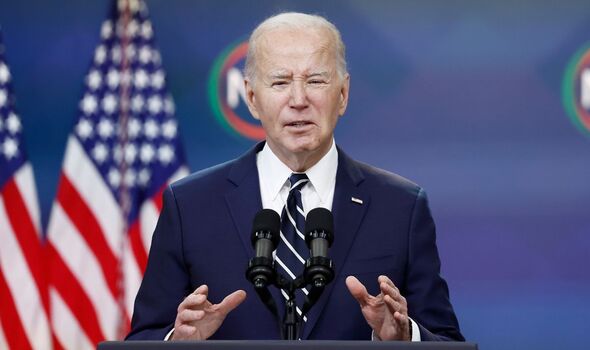
Joe Biden condemned Iran’s strikes while also urging Israel not to impulsively escalate the conflict (Image: GETTY)
Scenario 1: Devastating Israel air strike leading to all-out conflict – 20% chance
A major and devastating Israeli strike throughout Iran, hitting nuclear, political, military and civilian targets to completely degrade Tehran’s ability to carry out its long-term goal of destroying Israel. This would include attacks on Iran’s nuclear facilities.
Without America’s backing this would be very unlikely as it would put distance between Israel and its US sponsors, become an existential threat for itself and be devastating for the region and the rest of the world.
If Iran pushes Israel further, reneging on its declaration its attacks had stopped, that would drag the US and probably the UK into the war, possibly prompting a new global conflict.
But in that scenarios the west might see it has no choice.
At present, Iran has escalated to a significant degree. Despite Israel‘s recent aggressive stance, its war strategists have always factored into any potential conflict with Tehran that the Iranians must be given a reason to believe their nation could recover and prosper again after a war, even if it is militarily decimated.
However, this scenario seems unlikely at the moment due to the immense diplomatic pressure on Israel to defuse the situation.
Israel has already dismantled much of Hezbollah’s leadership, Iran’s primary and most dangerous proxy, so it hasn’t suffered significant military losses in the exchanges thus far.

Israel’s war cabinet, chaired by Benjamin Netanyahu, holds a meeting (Image: Israeli Government Press Office / Handout/Anadolu via Getty Images)
Scenario 2: Targeted Israeli air strike avoiding Iranian nuclear bases – 40% chance
A colossal bunker-buster bomb attack on Iran’s nuclear weapons research centres and extensive underground missile stores would be extremely provocative and risky, as there are no guarantees of success and it would be a high-risk strategy.
This might also involve a massive attack on a regime site or sites, possibly targeting very senior military leaders or government figures, but this too would significantly escalate the tit-for-tat exchanges.
This is unlikely because, while it would be a decisive response, it would be strongly discouraged by the US, who want the situation to de-escalate, especially with the ongoing war against Hamas in Gaza. However, Israel‘s war cabinet likely already knows what its response will be and is waiting to see if Iran’s claim that its attack is over is true.
This could likely spark a full-blown war as Tehran’s regime would be grappling with an existential threat. The fundamental purpose of its existence is to safeguard the revolution and extend Iranian dominance across the Middle East – all while recognising that it’s not the opportune moment to confront Israel and the US due to its military unpreparedness.
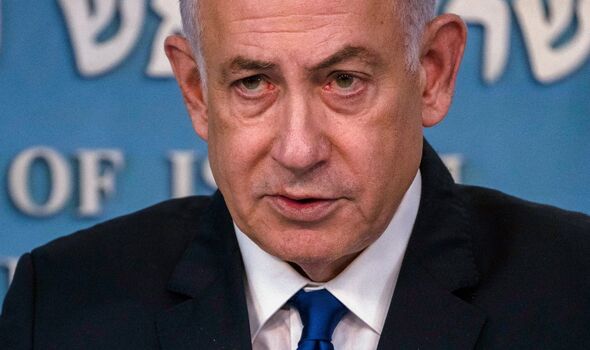
Israel’s Prime Minister Benjamin Netanyahu has stood firm in the conflict with Hamas (Image: GETTY)
Scenario 3: Minor demonstrative Israeli air strike on Iranian buildings – 80% chance
It’s inconceivable that Israel will remain passive, so it might bide its time for a few days, hoping Iran withdraws its long-range missile teams, then respond with a minor series of demonstrative strikes on Iranian structures causing minimal damage or casualties.
Israel‘s war cabinet will already have a strategy in place, which must include a target or targets within Iran itself.
Potential targets could encompass atomic science research centres, military buildings and weapons depots, pushing Iran to the edge while also weakening its military capability. The launch sites of the direct missile launches are a very probable target.
However, they are unlikely to neutralise them all, hence they need coalition partners the US and UK to be ready to assist in countering the inevitable missile retaliation.
Scenario 4: Devastating Israeli air strike on Hezbollah targets – 90% chance
Israel has launched a series of devastating attacks on pre-determined Hezbollah targets across Lebanon and Syria, continuing its mission to weaken the Iranian proxies. While this may not trigger an all-out war, it will undoubtedly deal a significant blow to Tehran by eliminating much of its most powerful strategic proxy force bordering Israel.
This could also involve one or a few strikes within Iran on a target calculated to avoid sparking a full-scale war, such as a building or complex, but not the nuclear programme. This is likely the most probable scenario and could require some time for coordination.
Coalition partners must be informed about the plans, and air-crews need to be ready to respond to potential retaliation from Iran’s missile teams.
Israeli intelligence and military planners have already identified detailed targets, some of which have been earmarked for possible attack for years. This is part of their escalation planning, enabling them to target sites and individuals in succession, with the capacity to strike increasingly important locations or people as a crisis escalates.
All enemy movements will surely ripple through the tactical plans. Each potential target in this rapidly escalating missile volley would possibly be screened to envision the expected repercussions of a strike.
In a setting such as the current one, which teeters on the brink of escalation yet doesn’t quite tip into full-blown combat, analysts might choose to keep larger targets in their back pocket for future escalation. However, if all-out war does break out, they might aim for strategically significant sites much sooner to reduce the adversary’s capacity for retaliation.
